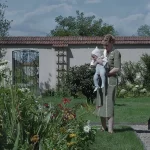The Outfit: Too Tight, by David Bax

Knowing only that I was about to watch a crime movie called The Outfit, I thought to myself, “It would be cool if this were actually about clothes.” So imagine my delight when it immediately becomes apparent that that truly is to what the title refers. Unfortunately–and despite the film’s considerable effort–that would turn out to be the only satisfying surprise on offer.
The Outfit introduces us to its main character–a Savile Row-trained tailor (though he’d prefer the term “cutter”) named Leonard (Mark Rylance)–and its setting–his shop in wintry late 1940s Chicago–via a monologue about the process of making a man’s suit, accompanied by a montage of the craftsman at work. Director Graham Moore, cinematographer Dick Pope and editor William Goldenberg provide as much loving attention to detail to the methods and movements as Leonard himself does. The Outfit is a handsome film throughout but this opening documentation of process is its most cinematic moment.
We soon learn that Leonard is connected with one of the city’s multiple organized crime families, not just making clothes for the boss (Simon Russell Beale) but allowing his shop’s backroom to be used as a place where high ranking members like Francis (Johnny Flynn) and the boss’ son Richie (Dylan O’Brien) may meet or leave each other messages and packages. Leonard’s shop thus serves a role not unlike the bar in Michaël R. Roskam’s 2014 The Drop, though whether or not Leonard is as complicit a participant in underworld doings as James Gandolfini’s Marv was is more or less the question driving the tension throughout The Outfit.
Moore and co-screenwriter Johnathan McClain set the entirety of the action inside Leonard’s business, which consists of three different spaces–a reception area, a showroom and the workshop at the back. That makes the whole thing feel like a play–even the establishing shot of the front of the store looks like it was built on a stage–but not in the wooden, one-note way such a description usually suggests. It’s elegant and austere in the same mode of Leonard’s philosophies of life and work. But it’s that same refusal to allow any room for anything messy that makes The Outfit feel overly neat and tidy.
If you wanted to, you could perhaps make an argument that the film’s serpentine plot is merely a trojan horse for a greater ambition to say something about humanity, culture and/or America. There is, without a doubt, an intentionality to the fact that so many of the characters are immigrants who, to get ahead in a society that devalues them, must choose to either work together or viciously compete with one another.
To be honest, however, I think that’s giving the movie too much credit. It is, at best, a secondary concern. Moore is primarily preoccupied with dazzling the viewer with twist and turns, knowing that he’s holding in reserve just enough information that you’ll never be able to complete the puzzle before he reveals it to you. The Outfit is proud of its own cleverness in a way of which a humble cutter like Leonard would certainly disapprove.




























